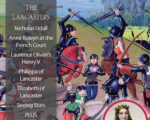
Here’s the full version of your monthly magazine: all about the house of Lancaster. The magazine is a whopping 80 pages long and it’s chock full of top articles as normal.
[Read More...]
Here’s the full version of your monthly magazine: all about the house of Lancaster. The magazine is a whopping 80 pages long and it’s chock full of top articles as normal.
[Read More...]
On this day in Tudor history, 27th March 1489, the Treaty of Medina del Campo was signed between England and Spain. One part of it was the arrangement of the marriage between Arthur, Prince of Wales, and Catherine (or Catalina) of Aragon. It was signed by Spain on this day and ratified in 1490 by Henry VII.
Find out more about this treaty and the betrothal and marriages (yes, plural!) of Arthur Tudor, Prince of Wales, and Catherine of Aragon in today’s talk.
[Read More...]
On this day in history, late on 26th March 1603, two days after the death of Queen Elizabeth I, Sir Robert Carey arrived at Holyrood in Edinburgh, Scotland, to inform King James VI that Queen Elizabeth I was dead and that James was now king.
It took Carey just two days to get from London to Scotland, and he had an accident on the way, but it was all worth it. Find out about his journey and what happened in today’s “on this day in Tudor history” talk.
[Read More...]
On this day in Tudor history, 25th March 1586, Good Friday and also Lady Day, the Feast of the Annunciation, Catholic martyr Margaret Clitherow (née Middleton), known as “the Pearl of York”, was pressed to death at the toll-booth on Ouse Bridge in York, under 7 or 8 hundredweight. She was executed for harbouring Catholic priests.
[Read More...]
On this day in Tudor history, 23rd March 1540, Waltham Abbey, an Augustinian house in Essex, was surrendered to the Crown. It was the last abbey to be dissolved in Henry VIII and Thomas Cromwell’s dissolution of the monasteries.
Find out more about this historic abbey, its origins and what’s left today, and also who profited from its lands, in today’s talk.
[Read More...]
On this day in Tudor history, 22nd March 1582, gunner, mathematician and writer, William Bourne was buried at Gravesend in Kent.
This popular author, who was able to explain technical matters for the common man in his books, was also a gunner, mathematician and inventor, yet he received no university education. He also drew plans for a submarine, although he never built it.
Find out more about the fascinating William Bourne and his works in today’s talk.
[Read More...]
On this day in Tudor history, 21st March 1603, a dying Queen Elizabeth I finally took to her bed.
Elizabeth I had been queen since November 1558, but now she was dying. She had deep-rooted melancholy, couldn’t sleep and was refusing to eat. She spent her days lying on cushions in her withdrawing chamber. But on 21st March, she was finally persuaded to go to bed.
Find out more about these last days in this talk.
[Read More...]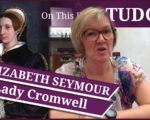
On this day in Tudor history, 19th March 1568, Elizabeth Seymour, Lady Cromwell, died. She was around fifty years old at her death.
Elizabeth was the sister of a queen, and a lord protector, and two of her brothers were executed as traitors, but what else do we know about Elizabeth Seymour and how is she linked to the Cromwell family and a portrait once thought to be of Queen Catherine Howard?
Find out more in today’s talk.
[Read More...]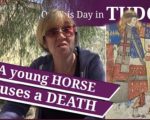
On this day in Tudor history, 13th March 1540, sixty-eight-year-old Henry Bourchier, 2nd Earl of Essex, died after suffering a broken neck in a horse-riding accident. Chronicler Charles Wriothesley recorded: “the Earl of Essex, riding a young horse, by misfortune cast him and brake his neck at his place in Essex, which was great pity.”
Henry Bourchier, 2nd Earl of Essex, was related to the royal family and served both Henry VII and Henry VIII. Find out more about this Tudor man in today’s talk.
[Read More...]
On this day in Tudor history, 6th March 1536, King Henry VIII’s Dissolution of the Monasteries began when the “Act for the Suppression (or Dissolution) of the Lesser Monasteries” was introduced into the Reformation Parliament.
The Dissolution of the Monasteries had a major impact on England and her people, but was of great benefit to the king, his nobles and the gentry. Find out what happened, why and its impact in this talk.
[Read More...]
On this day in history, 4th March 1609, Tudor spelling reformer and grammarian William Bullokar died at Chichester in West Sussex.
William Bullokar is known for writing the first grammar book of English, the “Pamphlet for Grammar”, and for his work reforming the alphabet to improve literacy. Find out more about him and what he did in today’s talk.
[Read More...]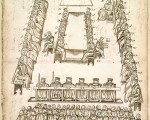
My work for the Tudor Society, book research and research for my “on this day” videos often has me researching the legal cases of Tudor people, from looking at indictments ro records of their actual trials. It is fascinating and it’s wonderful that we have so many resources freely available.
[Read More...]
On this day in Tudor history, 26th February 1552, Sir Thomas Arundell, Sir Michael Stanhope, Sir Miles Partridge and Sir Ralph Fane (or Vane) were executed. The men had been condemned as traitors after being accused of conspiring with Edward Seymour, Duke of Somerset and former Lord Protector, against John Dudley, Duke of Northumberland, the new man in control of King Edward VI’s government.
Find out all about these men and how these loyal royal servants came to these sticky ends in today’s talk.
[Read More...]

On this day in Tudor history, 25th February 1570, Pope Pius V issued the papal bull “Regnans in Excelsis”. This bull not only excommunicated Queen Elizabeth I, it also freed her Catholic subjects from their allegiance to her and called on the English people to disobey her orders, mandates and laws. It threatened excommunication for those who did obey her.
It put Elizabeth I in danger and it put Catholics in an impossible situation.
Find out more about the bull and its impact in today’s talk.
[Read More...]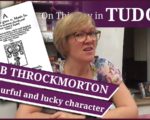
On this day in Tudor history, 23rd February 1601, religious pamphleteer and Member of Parliament, Job Throckmorton, was buried at Haseley in Warwickshire.
Job was known for his alleged involvement in the “Marprelate Controversy”, a pamphlet war, and also for his colourful Parliamentary speeches, which nearly got him into trouble. He was lucky to escape imprisonment and worse!
Find out more about Job Throckmorton in today’s talk.
[Read More...]
On this day in Tudor history, 22nd February 1540, twenty-four-year-old Marie de Guise, or Mary of Guise, queen consort of King James V of Scotland, was crowned queen at Holyrood Abbey.
Did you know that Henry VIII was keen on making Marie de Guise his fourth wife? She declined, saying that her neck was small! Instead, she married James V.
Marie was, of course, the mother of Mary, Queen of Scots, and you can find out more about her in today’s talk.
[Read More...]
On this day in Tudor history, 14th February 1539, Sir Nicholas Carew, a royal favourite for over 20 years, was tried for treason after being implicated in the Exeter Conspiracy. Spoilers – his trial didn’t go well.
But how did a man who’d been in royal favour for so long come to such a sticky end? Find out in today’s talk.
[Read More...]
On this day in history, 13th February 1608, prominent Tudor noblewoman and one of the richest people in England, Elizabeth Talbot, Countess of Shrewsbury, more commonly known as Bess of Hardwick, died at her home at Hardwick.
Bess of Hardwick is known for her building projects, which included Chatsworth and Hardwick Hall, her beautiful needlework and the fact that she and Shrewsbury were guardians of the captive Mary, Queen of Scots.
Find out more about this fascinating Tudor lady in today’s talk.
[Read More...]
On this day in Tudor history, 12th February 1590, Blanche Parry, died at the age of 82. She had served Queen Elizabeth I loyally from Elizabeth’s birth in 1533,and had been a constant in the queen’s life.
Find out more about this interesting lady and how she served her queen in today’s talk.
[Read More...]
On this day in Tudor history, 8th February 1601, Robert Devereux, 2nd Earl of Essex and Queen Elizabeth I’s former favourite, did a rather foolish thing and raised a rebellion against the queen and her council.
Spoilers: It didn’t go well and he ended up being executed as a traitor.
Find out exactly what happened in today’s talk.
[Read More...]
On this day in history, 7th February 1477 or 1478, Sir Thomas More, Henry VIII’s Lord Chancellor, was born in London.
More had once wanted to be a monk but ended up being one of the most well-known statesmen of the Tudor period. Unfortunately, Sir Thomas More came to a sticky end after refusing to sign the oath recognising Henry VIII as the supreme head of the church in England, and was executed in 1535 as a traitor.
Find out all about More’s rise to power, how he fell, and what he told his son-in-law about the king, in today’s talk.
[Read More...]
On this day in Tudor history, 5th February 1549, in the reign of King Edward VI, fifteen-year-old Elizabeth, the future Queen Elizabeth I, was summoned to appear before Sir Robert Tyrwhitt, who was keeping her under house arrest at Hatfield while the Crown investigated Thomas Seymour.
Edward VI’s privy council were investigating whether Elizabeth was secretly plotting to marry Thomas Seymour, Edward VI’s uncle, helped by her servants, Katherine Ashley and Thomas Parry.
Parry and Ashley had made confessions, but what had they said? And what would happen to them all?
Find out in today’s talk.
[Read More...]
Here’s the full version of your monthly magazine: all about Rebellion and how a number of critical moments could have changed Tudor history forever.
[Read More...]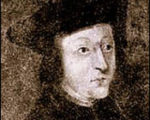
Eustace Chapuys was born in Annecy; his exact birth date is unknown but is believed to be between 1490 and 1492. He was the second son of Louis Chapuys, notary of Annecy in the Duchy of Savoy.
Eustace Chapuys was a very well-educated man, attending the University of Turin in 1507, where it is believed he stayed for five years, leaving in around 1512. Chapuys became a doctor of civil and canon laws and had an interest in humanist scholarship. His degree paved the way for his appointment in 1517 when he was employed as an official to the Bishop of Geneva and represented the bishop in the government of the city. In the years following this appointment, Chapuys delicately handled strained political alliances, representing his bishop and the Duke of Savoy. In 1525, Chapuys entered the services of the Duke of Bourbon, acting as his ambassador to Charles V’s court in Granada. Following the death of the Duke of Bourbon, Eustace entered into the service of Charles V the Holy Roman Emperor, and by the 25th June 1529, he was appointed as Charles V’s ambassador to England. It is this appointment which guarantees Chapuys’ place in history as an important historical figure.
[Read More...]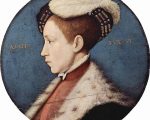
On this day in history, 28th January 1547, nine-year-old Edward, son of Henry VIII and Jane Seymour, became King Edward VI, succeeding his father, King Henry VIII, who died on this day at Whitehall Palace. Edward didn’t hear the news of his father’s death until the next day, when he was told of it by Edward Seymour and Anthony Denny.
Here are some resources on this young Tudor king…
[Read More...]
On this day in Tudor history, 23rd January 1571, after dining with its founder, Sir Thomas Gresham, Queen Elizabeth I opened the Royal Exchange in London.
Find out more about the official opening, what the Royal Exchange was, why Gresham paid for its building, and what happened to it, in today’s talk.
[Read More...]
On this day in Tudor history,18th January 1486, twenty-nine year-old King Henry VII married twenty year-old Elizabeth of York at Westminster Abbey.
This was over two years after he had vowed to marry her and nearly 5 months after his victory at the Battle of Bosworth Field. Why did Henry VII delay in marrying Elizabeth of York?
Find out what delayed the marriage, and more about the bride and groom, in today’s talk.
[Read More...]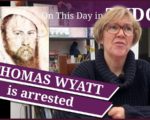
On this day in Tudor history, 17th January 1541, courtier, diplomat and poet, Sir Thomas Wyatt the Elder, was arrested and sent to the Tower of London after being accused of corresponding with Cardinal Reginald Pole, and referring to the prospect of Henry VIII’s death.
Wyatt was taken to the Tower and it looked like he’d be executed, but he was saved by Queen Catherine Howard, but at a huge cost.
Find out more about what Wyatt was accused of, how he escaped execution and what he had to agree to, in today’s talk.
[Read More...]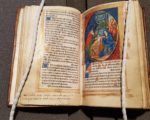
Thank you so much to Tudor Society member Corinna Hahn for asking the following question for our “Expert Answers” section. It’s a very interesting question.
I (Claire) opted to answer this one as I’ve done lots of research on the two books of hours in the collection at Hever Castle, and I was lucky enough to hold them and talk to my dear friend, castle supervisor, Owne Emmerson, about them back in May. I’ve included the video below my answer so that you can find out all about these beautiful books.
Here is Corinna’s question in full:
“I’ve got some questions about one book of hours that Anne Boleyn owned and that is now at Hever Castle. It’s the one with Anne Boleyn’s inscription under a prayer adjacent to a miniature of the presentation of Jesus in the temple. The inscription reads “Remember me when you do pray that hope doth lead from day to day.”
This rhyme has intrigued me for years, since we don’t know when and where Anne wrote it, to whom she wrote it and what the real message behind her inscription was.
It seems to me that Anne didn’t write in her prayer books heedlessly, every inscription she has left somewhere is there for a reason and where she placed her “Remember me” rhyme could possibly be a clue to the point of time when she wrote these words.
My questions are: Under which text did she write her “Remember me” rhyme? Is there a transcription and/or translation of this text? Why did she place her message there? Was the rhyme she wrote meant as a prayer request or a farewell to someone? Is it known who owned the prayer book after her death? Where was the book before Hever Castle acquired it?”